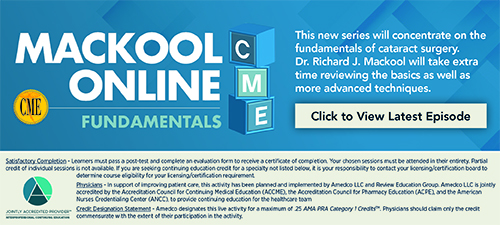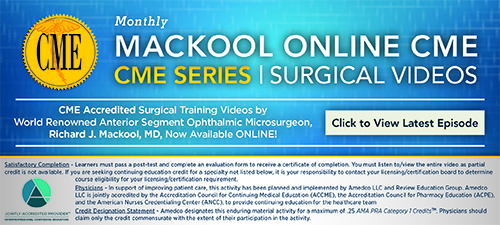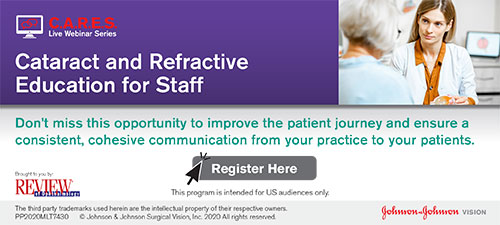| |
|
|
|
| Vol. 20, #48 • Monday, November 16, 2020 |
|
NOVEMBER IS DIABETIC EYE DISEASE AWARENESS MONTH
|
|
|
| |
|
Effect of Vitamin D and ω-3 Fatty Acid Supplementation on AMD Risk
Researchers wrote that observational studies suggest that higher intake or blood levels of vitamin D and marine ω-3 fatty acids may be associated with lower risks of age-related macular degeneration; however, randomized trial evidence is limited. As such, they evaluated whether daily supplementation with vitamin D3, marine ω-3 fatty acids, or both prevented the development or progression of AMD.
This prespecified ancillary study focused on the Vitamin D and Omega-3 Trial (VITAL), a nationwide, placebo-controlled, 2 × 2 factorial design randomized clinical trial of supplementation with vitamin D and marine ω-3 fatty acids for the primary prevention of cancer and cardiovascular disease. Participants included 25,871 men and women in the United States. Randomization occurred from November 2011 to March 2014, and study pill-taking ended as planned on December 31, 2017.
Interventions included vitamin D3 (cholecalciferol), 2,000 IU per day; and marine ω-3 fatty acids, 1 g per day. The primary endpoint was total AMD events—a composite of incident AMD cases plus cases of progression to advanced AMD from baseline AMD, based on self-reports confirmed by medical record review. Analyses were conducted using the intention-to-treat population.
In total, 25,871 participants with a mean age of 67.1 ±7 years were included in the trial. Of them, 50.6 percent were women, 71.3 percent were self-declared non-Hispanic white participants, and 20.2 percent were black participants. Here were some of the findings:
• During a median (range) of 5.3 (3.8 to 6.1) years of treatment and follow-up, 324 participants experienced an AMD event (285 incident AMD, and 39 progression-to-advanced-AMD cases).
• For vitamin D3, 163 events were reported in the treated group and 161 in the placebo group (HR, 1.02; CI, 0.82 to 1.27).
• For ω-3 fatty acids, 157 events were reported in the treated group and 167 in the placebo group (HR, 0.94; CI, 0.76 to 1.17).
• In analyses of individual components for the primary endpoint, HRs comparing vitamin D3 groups were 1.09 (CI, 0.86 to 1.37) for incident AMD and 0.63 (CI, 0.33 to 1.21) for AMD progression.
• For ω-3 fatty acids, HRs were 0.93 (CI, 0.73 to 1.17) for incident AMD and 1.05 (CI, 0.56 to 1.97) for AMD progression.
Researchers wrote that neither vitamin D3 nor marine ω-3 fatty acid supplementation had a significant overall effect on AMD incidence or progression.
SOURCE: Christen WG, Cook NR, Manson JE, et al; VITAL Research Group. Effect of vitamin d and ω-3 fatty acid supplementation on risk of age-related macular degeneration: An ancillary study of the vital randomized clinical trial. JAMA Ophthalmol 2020; Oct 29. [Epub ahead of print].
|
|
|
|
|
| |
|
Malpractice Litigation in Glaucoma
Investigators analyzed and reported the causes and outcomes of malpractice litigation for patients with a diagnosis of glaucoma, as part of a retrospective case series.
The WestLaw legal database was reviewed for all malpractice litigation involving ophthalmologist defendants in the United States between 1930 and 2014. All litigation involving glaucoma was included in this analysis and compared to litigation in ophthalmology as a whole.
The primary outcomes were the number of cases, jury award amounts, if the case resolved in favor of the defendant, and the type of glaucomatous disease or procedure with the highest amount of litigation.
Sixty-nine glaucoma malpractice cases were included. Here were some of the findings:
• Overall, 62.3 percent of cases were resolved in favor of defendants.
• Twenty-nine cases were resolved via jury trial, eight of which were associated with plaintiff verdicts with a mean adjusted jury award of $994,260.
• Ten cases resulted in settlements with mean adjusted indemnity of $1,210,414.
• Commonly litigated allegations included mismanagement of glaucoma (20.3 percent), failure to diagnose glaucoma (17.4 percent), failure to diagnose or mismanagement of angle-closure glaucoma (18.5 percent), adverse drug effects (14.5 percent) and trabeculectomy complications (8.7 percent).
• Overall, the median plaintiff award for all of glaucoma litigation was $977,476; the median award across all ophthalmic subspecialties was $568,302 (p=0.25).
• For jury verdicts alone, the median award in glaucoma was $977,474 compared with $604,352 for all of ophthalmology (p=0.05).
• For settlements alone, the median indemnity payment in glaucoma was $955,988 compared to $827,051 for all of ophthalmology (p=0.24).
Investigators wrote that, overall, the rate of plaintiff verdicts was similar in glaucoma and in ophthalmology as a whole; however, the magnitude of plaintiff awards was higher in glaucoma than in ophthalmology in general. They added that common scenarios leading to litigation included failure to diagnose or mismanagement of glaucomatous disease, as well as adverse drug effects and surgical complications. Furthermore, the investigators wrote, many cases could have been avoided with careful examinations, thorough documentation in the patients' chart and detailed conversations with patients.
SOURCE: Engelhard SB, Justin GA, Craven ER, et al. Malpractice litigation in glaucoma. Ophthalmol Glaucoma 2020; Oct 27. [Epub ahead of print].
|
|
|
|
|
|
|
| |
Complimentary CME Education Videos
|
|
|
|
|
| |
|
Penetrating Keratoplasty: A 20-year Review in Asian Eyes
Scientists reviewed the long-term outcomes of optical, therapeutic and tectonic forms of penetrating keratoplasty over a 20-year period in Asian eyes, as part of a prospective cohort study involving the Singapore Corneal Transplant Study.
All penetrating keratoplasties performed at the Singapore National Eye Centre (SNEC) from January 1991 to December 2010 were analyzed using records from the computerized database of the SCTS. This database included preoperative, intraoperative and postoperative patient data and donor data. Only primary grafts were included. Scientists looked at patient demographics, donor sources, indications for grafting, complications, graft survival rates and causes of graft failure.
A total of 1,206 primary PKs were performed. The mean age of the patients was 55 years (range: <1 to 101 years). Here were some of the findings:
• The overall corneal graft survival rates at the following years were as follows:
o one, 91 percent;
o five, 66.8 percent;
o 10, 55.4 percent;
o 15, 52 percent; and
o 20, 44 percent.
• For optical grafts, pseudophakic bullous keratopathy, post-infectious corneal scarring/thinning and keratoconus were the most common diagnoses.
• Graft survival for optical grafts was significantly better compared with therapeutic and tectonic grafts at all time points.
• Multivariate analysis suggested that younger donor age and higher donor endothelial cell count were associated with better long-term graft survival for optical grafts.
• Irreversible allograft rejection and late endothelial failure accounted for more than 60 percent of graft failures.
Scientists concluded that graft survival decreased over time—from 91 percent at one year to 44 percent at 20-year follow-up.
SOURCE: Anshu A, Li L, Htoon HM, et al. Long-term review of penetrating keratoplasty: A 20-year review in Asian eyes. Am J Ophthalmol 2020; Oct 28: [Epub ahead of print].
|
|
|
|
|
| |
Complimentary CME Education Videos
|
|
|
|
| |
|
New Model of Care for DR Complications: The EMERALD Study
Researchers wrote that increasing diabetes prevalence and the advent of new treatments for diabetes’ major visual-threatening complications (diabetic macular edema and proliferative diabetic retinopathy) requiring frequent and lifelong follow-up have markedly increased hospital demands. Given that resulting delays in the evaluation/treatment of patients can lead to sight loss, they added that strategies to increase the capacity of medical retina clinics are urgently needed. EMERALD tested the diagnostic accuracy, acceptability and cost of a new diagnostic pathway for people with previously treated DME/PDR. Optos provided instruments for the researchers.
The prospective, multicenter cross-sectional study involving 13 hospitals in the United Kingdom included adults with type 1 or 2 diabetes who successfully treated DME/PDR, and who had active or inactive disease at the time of enrollment.
Researchers evaluated a new diagnostic pathway involving multimodal imaging (spectral-domain optical coherence tomography for DME, and 7-field Early Treatment Diabetic Retinopathy Study and ultra-widefield fundus images for PDR) interpreted by trained non-medical staff to detect reactivation of disease. The researchers compared the new pathway with the current standard of care (ophthalmologists’ face-to-face examinations).
The primary outcome was sensitivity of the new pathway. The secondary outcomes were:
• specificity;
• agreement between pathways;
• cost;
• acceptability;
• percentage of patients requiring subsequent ophthalmologist assessment unable to undergo imaging or with inadequate images/indeterminate findings.
Here were some of the findings:
• The new pathway had sensitivity of 97 percent (CI, 92 to 99 percent) and specificity of 31 percent (CI, 23 to 40 percent) to detect DME.
• For PDR, 7-field ETDRS, sensitivity (85 percent, 95 percent CI, 77 to 91 percent) and specificity (48 percent; CI, 41 to 56 percent) were comparable to UWF sensitivity (83 percent, CI, 75 to 89 percent) and specificity (54 percent; CI, 46 to 61 percent).
• For detection of high-risk PDR, sensitivity (87 percent, CI, 78 to 93 percent) and specificity (49 percent, CI, 42 to 56 percent) were higher when using UWF images vs. sensitivity (80 percent, CI, 69 to 88 percent) and specificity (40 percent, CI, 34 to 47 percent) for 7-field ETDRS.
• Participants preferred ophthalmologist assessments; when ophthalmologists were absent, they requested immediate feedback from graders and maintained periodic ophthalmologist evaluations.
• Researchers suggested the new pathway, compared with the current standard of care, could save $1792.61/100 DME visits, and between $594.53 and $1,533.39/100 PDR visits.
Researchers reported that fully-automated localization and quantification of IRF/SRF over time shed light on the fluid dynamics in each disease. They found a specific anatomical response by IRF/SRF to anti-VEGF therapy in all diseases studied.
Researchers reported that the new ophthalmic grader pathway had acceptable sensitivity, and may free up resources for ophthalmologists by helping to evaluate patients with DME and PDR. They say the study’s limitations included the fact that images of the iris and anterior chamber angle weren’t obtained for the evaluation of people with PDR, so any new vessels that developed—though rare—would be missed. Additionally, fluorescein angiography wasn’t performed to determine the actual activity of the PDR.
SOURCE: Lois N, Cook JA, Wang A, et al; EMERALD Study Group. Evaluation of a new model of care for people with complications of diabetic retinopathy: The EMERALD Study. Ophthalmology 2020; Oct 29. [Epub ahead of print].
|
|
|
|
|
|
|
|
| |
Advertisement
|
|
|
|
|
Industry News
Lineage Completes Enrollment in Phase I/IIa OpRegen Cell Therapy Study
Lineage Cell Therapeutics announced the successful completion of enrollment in its 24-patient Phase I/IIa study of its lead product candidate, OpRegen. OpRegen is an investigational cell therapy consisting of retinal pigment epithelium cells administered to the subretinal space for the treatment of dry age-related macular degeneration with geographic atrophy. Updated interim results were presented at the American Academy of Ophthalmology virtual meeting during the OP02V Retina, Vitreous Original Papers Session on November 15.
Read more.
NGM Bio to Present Phase I Data on NGM621 at AAO Virtual Meeting
NGM Biopharmaceuticals Phase I data on NGM621, which was featured in a poster presentation at the American Academy of Ophthalmology 2020 virtual meeting (November 13 to 15), included first-in-human safety, tolerability and pharmacokinetics findings from single and multiple intravitreal injections of NGM621 in patients with geographic atrophy. Read more.
Neuraly & Penn to Explore Use of NLY01 to Target Glaucoma
Neuraly announced a strategic sponsored research agreement with the University of Pennsylvania to study the use of the company’s drug NLY01 to therapeutically target a neuroinflammatory mechanism of glaucoma. Preliminary evidence shows NLY01 has potential clinical use for the treatment of glaucoma and other retinal diseases characterized by deleterious glial cell activity. Read more.
B+L Highlights Innovations at AAO
Bausch + Lomb announced highlighted its latest surgical, pharmaceuticals and consumer health-care innovations, as well as several new business ventures at the company’s virtual exhibit booth during the Annual Meeting of the American Academy of Ophthalmology virtual meeting, which took place Nov. 13 to 15. The company also offered attendees the opportunity to participate in a variety of Industry Showcase presentations, during which surgeons discussed topics postoperative case management, phacodynamics, glaucoma and vitreoretinal surgery. View the innovations featured.
Gyroscope Announces First Patient Dosed in HORIZON Trial
Gyroscope Therapeutics announced the first patient was dosed in the Phase II HORIZON trial evaluating GT005 in people with geographic atrophy secondary to dry age-related macular degeneration. GT005 is an investigational one-time AAV-based gene therapy. Read more.
Apellis Announces Late-breaking Presentation Database Study on GA
Apellis Pharmaceuticals, a company working on a treatment for geographic atrophy, announced findings from the largest retrospective database study in geographic atrophy secondary to age-related macular degeneration. The analysis of the American Academy of Ophthalmology (AAO) IRIS (Intelligent Research in Sight) Registry was conducted in partnership with Verana Health. The data were presented in a late-breaking oral session on November 13 as part of the Retina Subspecialty Day at the American Academy of Ophthalmology virtual meeting. See some of the key findings.
|
|
|
|
|
|
| |
Review of Ophthalmology® Online is published by the Review Group, a Division of Jobson Medical Information LLC (JMI), 19 Campus Boulevard, Newtown Square, PA 19073.
To subscribe to other JMI newsletters or to manage your subscription, click here.
To change your email address, reply to this email. Write "change of address" in the subject line. Make sure to provide us with your old and new address.
To ensure delivery, please be sure to add reviewophth@jobsonmail.com to your address book or safe senders list.
Click here if you do not want to receive future emails from Review of Ophthalmology Online.
Advertising: For information on advertising in this e-mail newsletter or other creative advertising opportunities with Review of Ophthalmology, please contact sales managers Michael Hoster, Michele Barrett or Jonathan Dardine.
News: To submit news or contact the editor, send an e-mail, or FAX your news to 610.492.1049
|
|
|
|
|
|
|
|